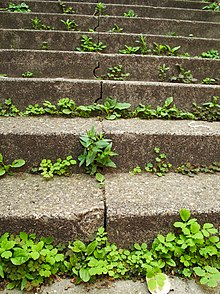
Back Onkruid Afrikaans አረም Amharic حشيشة Arabic Maleza AST Alaq Azerbaijani Ҡый үләндәре Bashkir Piktžuolė BAT-SMG Пустазелле Byelorussian Пустазельле BE-X-OLD Плевел Bulgarian

A weed is a plant considered undesirable in a particular situation, growing where it conflicts with human preferences, needs, or goals.[1][2][3][4] Plants with characteristics that make them hazardous, aesthetically unappealing, difficult to control in managed environments, or otherwise unwanted in farm land, orchards, gardens, lawns, parks, recreational spaces, residential and industrial areas, may all be considered weeds.[4][2][5] The concept of weeds is particularly significant in agriculture, where the presence of weeds in fields used to grow crops may cause major losses in yields.[6] Invasive species, plants introduced to an environment where their presence negatively impacts the overall functioning and biodiversity of the ecosystem, may also sometimes be considered weeds.[7][8]
Taxonomically, the term "weed" has no botanical significance, because a plant that is a weed in one context, is not a weed when growing in a situation where it is wanted. Some plants that are widely regarded as weeds are intentionally grown in gardens and other cultivated settings. For this reason, some plants are sometimes called beneficial weeds. Similarly, volunteer plants from a previous crop are regarded as weeds when growing in a subsequent crop. Thus, alternative nomenclature for the same plants might be hardy pioneers, cosmopolitan species, volunteers, "spontaneous urban vegetation," etc.[9]
Although whether a plant is a weed depends on context, plants commonly defined as weeds broadly share biological characteristics that allow them to thrive in disturbed environments and to be particularly difficult to destroy or eradicate. In particular, weeds are adapted to thrive under human management in the same way as intentionally grown plants.[1] Since the origins of agriculture on Earth, agricultural weeds have co-evolved with human crops and agricultural systems, and some have been domesticated into crops themselves after their fitness in agricultural settings became apparent.[10]
More broadly, the term "weed" is occasionally applied pejoratively to species outside the plant kingdom, species that can survive in diverse environments and reproduce quickly; in this sense it has even been applied to humans.[11]
Weed control is important in agriculture and horticulture. Methods include hand cultivation with hoes, powered cultivation with cultivators, smothering with mulch or soil solarization, lethal wilting with high heat, burning, or chemical attack with herbicides and cultural methods such as crop rotation and fallowing land to reduce the weed population.[12]
- ^ a b Bridges, David C. (1994). "Impact of Weeds on Human Endeavors". Weed Technology. 8 (2): 392–395. doi:10.1017/S0890037X00038987. JSTOR 3988124. S2CID 90116503.
- ^ a b Harlan, J. R., & deWet, J. M. (1965). Some thoughts about weeds. Economic botany, 19(1), 16-24.
- ^ "Define the term weed". forages.oregonstate.edu. Oregon State University Forage Information System. June 2009.
- ^ a b "What is a Weed". Snohomish County Extension Office.
- ^ Holzner, W., & Numata, M. (Eds.). (2013). Biology and ecology of weeds (Vol. 2). Springer Science & Business Media.[page needed]
- ^ Chauhan, BS (2020). "Grand Challenges in Weed Management". Front. Agron. 1 (3). doi:10.3389/fagro.2019.00003.
- ^ Nakano, Michelle (13 February 2020). "21: Characteristics of weedy species". Red Seal Landscape Horticulturist Identify Plants and Plant Requirements. Kwantlen Polytechnic University.
- ^ Janick, Jules (1979). Horticultural Science (3rd ed.). San Francisco: W.H. Freeman. p. 308. ISBN 0-7167-1031-5.
- ^ Stromberg, Juliet C. (2023). Bringing Home the Wild: A Riparian Garden in a Southwest City. Tucson: University of Arizona Press. p. 29. ISBN 978-0-8165-5028-9.
- ^ Guglielmini, A.C.; Ghersa, C.M.; Satorre, Emilio Horacio (2007). "Co-evolution of domesticated crops and associated weeds". Ecologia Austral. 17 (1).
- ^ David Quammen (October 1998), "Planet of Weeds" (PDF), Harper's Magazine, retrieved November 15, 2012
- ^ Blackshaw, R. E., Anderson, R. L., & Lemerle, D. E. I. R. D. R. E. (2007). Cultural weed management. Non-Chemical Weed Management: Principles, Concepts and Technology, Wallingford, UK: CAB International, 35-48.
© MMXXIII Rich X Search. We shall prevail. All rights reserved. Rich X Search